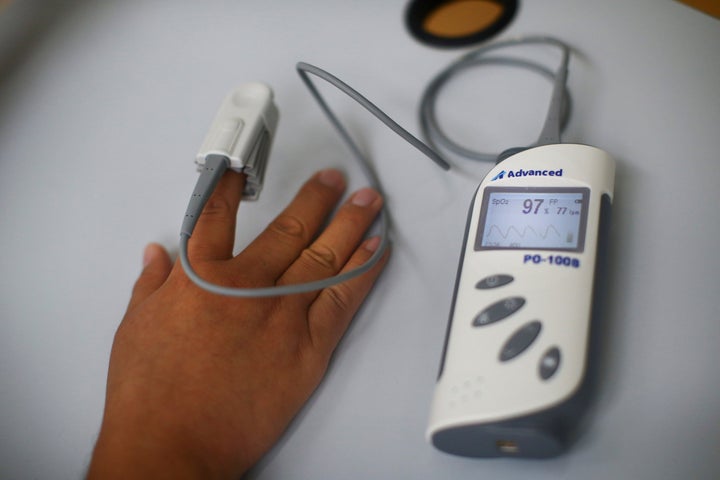Pulse oximeters are becoming increasingly popular for home use, as people buy them to monitor if someone in the family becomes seriously ill with Covid-19.
The devices, which measure the percentage of oxygen in the blood when clipped on to a fingertip, have been praised by doctors because they can alert people who don’t realise they’re gravely ill to the fact that their body is struggling for oxygen.
One of the biggest worries with Covid-19 is when someone doesn’t realise their oxygen levels have dropped because they don’t actually feel unwell – a phenomenon sometimes referred to as happy hypoxia or silent hypoxia.
Dr David Strain, a clinical academic at the University of Exeter Medical School and clinician at the Royal Devon and Exeter Hospital, tells HuffPost UK: “Ordinarily if your oxygen level drops below about 96% you start to feel short of breath, you start to be aware that you’re struggling to get oxygen in.”
But one of the features he and other clinicians have witnessed with Covid-19 is when patients have had oxygen saturations of around 75-80% – which ordinarily would make you gasp for air, as if you’d just run a marathon – “but they’ve been sat on the ward completely fine with no symptoms and not telling us [that anything is wrong],” he says.
How do pulse oximeters work?
A pulse oximeter works by shining a light through a person’s fingertip (or earlobe) and calculating how much oxygen is in the blood. A normal reading would usually range from 95-100%.
What kind of reading is a red flag?
Official guidance from NHS England suggests you should call NHS 111 if somone’s blood oxygen level is 94% or 93%, or continues to be lower than their usual reading. Some people with lung conditions, for example, might routinely have lower readings but if their percentage drops more, they should seek help.
If someone’s blood oxygen levels are 92% or less, you should call 999 or go to A&E – although the NHS advises taking the reading twice to check it is correct.
In October 2020, Nigel Watson, chief executive of Wessex Local Medical Committees, told the BMJ that evidence is fairly strong that if oxygen saturation falls to 94% or 93%, the mortality risk with Covid-19 increases to around 13%. If it falls below that level, the risk increases to about 28%.
Why are pulse oximeters useful?
It’s vital that people seek medical assistance for low oxygen levels, as if left unchecked, it could cause further damage to the body.
“When the oxygen in the blood starts to fail, if we can then put oxygen on, it means we can protect the rest of the body from the effects of low oxygen,” says Dr Strain, “and hopefully that may be one of the steps of preventing long Covid and some of the longer term symptoms.
“Some of the symptoms of long Covid are because of the fact the brain, or the body, has suffered for periods without oxygen.”

Who might need a pulse oximeter?
Most people who get Covid have very few complications, meaning they will be able to recover at home without the need for pulse oximeters.
However there are a number of patients who might benefit from such devices. For instance, some people who don’t need immediate hospital attention but are at high risk of developing serious symptoms from Covid-19 have been given pulse oximeters to use at home by the NHS.
Some people might also be at risk of developing infections if they stay in hospital, so the safest option is to send them home with a pulse oximeter so they can monitor their recovery.
Those who are more at risk of complications from the virus, either because of age, underlying illness or another risk factor, may want to purchase a pulse oximeter for themselves.
However, prices can vary hugely and how well they work might also vary, with different devices offering different readings.
Some tech gadgets such as Fitbits and Apple watches also have ways to monitor your blood oxygen, however it’s worth noting that readings might not be as accurate and the companies themselves advise that the measurements given are not intended for medical use.
What are the downsides?
Dr Strain explains that the devices used in hospital are all validated and “have a very good track record”. They also cost a lot more than the ones you’d find in your local pharmacy, meaning the results from cheaper versions might be less accurate.
“Our devices in hospital cost several hundred pounds, if not thousands of pounds in some places, so clearly the level of technology will be different between them and the technology you might buy in chemists for £20,” he says.
The machines may also work less well monitoring oxygen levels in Black people. with a study from the US revealing the devices can provide misleading results in more than one in 10 Black patients.
Researchers analysed pulse oximetry measures of oxygen saturation and measures of arterial oxygen saturation in arterial blood gas from 1,333 white patients and 276 Black patients who were hospitalised earlier in 2020.
They found pulse oximeters overestimated oxygen levels 3.6% of the time in white patients, but got it wrong almost 12% of the time in Black patients, the New York Times reported.
“Given the widespread use of pulse oximetry for medical decision making, these findings have some major implications, especially during the current coronavirus disease 2019 (Covid-19) pandemic,” the researchers concluded.
“Our results suggest that reliance on pulse oximetry to triage patients and adjust supplemental oxygen levels may place Black patients at increased risk for hypoxemia [a low level of oxygen in the blood].”
Nail varnish, tattoos and false nails can also affect a person’s reading, according to The British Lung Foundation, as can medical conditions including anaemia and Raynaud’s syndrome.
